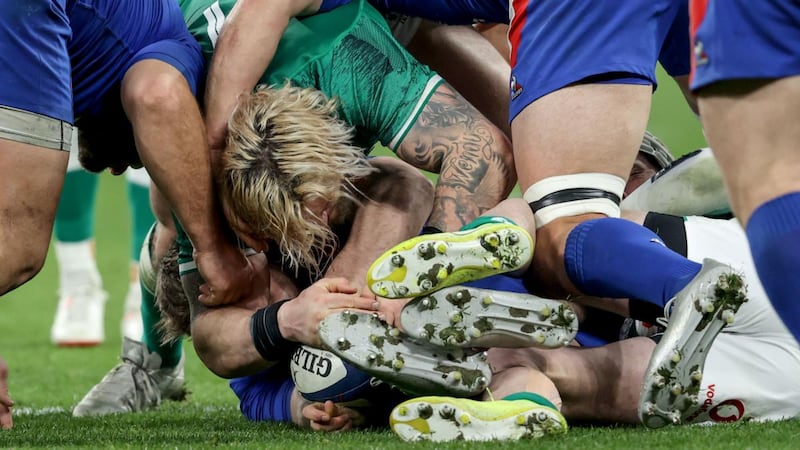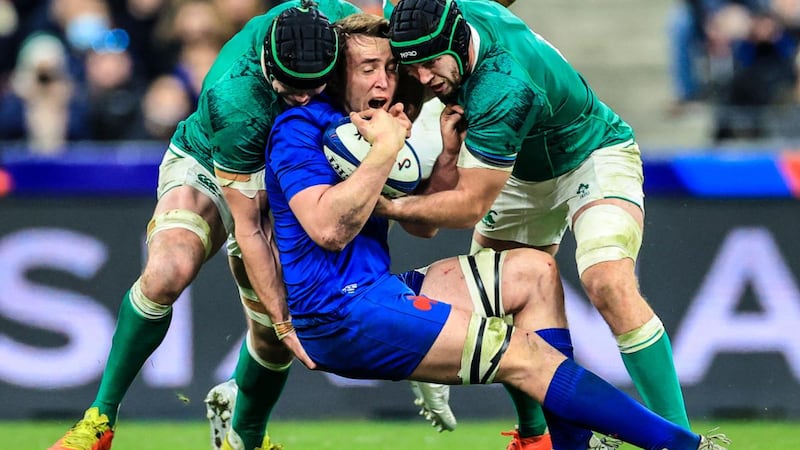The manner in which the Six Nations match at the Stade de France panned out brought to mind a boxing analogy, the famous heavyweight clash of Muhammad Ali and George Foreman, The Rumble in the Jungle in Zaire.
The Ireland rugby team played both roles, initially that of Ali, as they absorbed ferocious punishment in the early exchanges with one brief, notable respite in the form of Mack Hansen's virtuosity. But Ireland certainly didn't pre-plan any rope-a-dope tactics; they were just pummelled remorselessly by France for much of the first half.
There is an obvious physical toll to absorbing that amount of pressure so it is to their credit that Ireland fought back with those two quick tries after half-time. France's response was immediate and brutal, the collision between Peter O'Mahony and Cyril Baille summing up the hugely attritional nature of this encounter.
France unloaded from the bench their version of the ‘equipe de bombe’ and the Irish error rate increased as they tired. At this point Andy Farrell’s side had swapped the role of Ali for that of Foreman. They kept swinging but couldn’t land a decisive blow.
I wouldn't be too downbeat as the future remains bright despite the defeat. Ireland's Six Nations fortunes are out of their hands, all they can do is to win the remaining three matches and leave the French results to the gods. Either way, they can walk away with no regrets. However, anything less than three wins and previously unanswered questions may begin to resurface.
The French would have expected a great return from their first-half dominance but, while Ireland did leak points in the form of penalties, they kept the home side at arm's length from the Irish line with the exception of the Antoine Dupont try. To be trailing 19-7 at half-time was a decent effort in the context of the match at that point.
Scoring two quick tries on the resumption reveals plenty about the character of the team and it briefly turned the match on its head. At 22-21, the next score was going to colour the end game to a point. The psychological lift of Ireland going ahead would have asked huge questions about the French temperament. The visitors couldn’t manage this so we’ll never know.

Fabien Galthie’s decision to select six forwards in the replacements was both a hat tip to Ireland but also recognition that it could be pivotal in the end game. It was certainly a factor in the final quarter, albeit that the visitors could still have won the match.
I have previously explored New Zealand’s inability to problem-solve on the field in the November Test match between the countries in terms of being able to disrupt both Ireland’s lineout platform which is pivotal to their attacking patterns and also ruck speed, also a central tenet in Farrell’s game plan.
The third quarter was the only time the visiting team were able to apply any territory-based pressure
French defence coach, Shaun Edwards, had weeks to prepare specifically for this match and came up with the gambit of a shooter on the first receiver, Antoine Dupont presence in the front-line rather than sweeping in behind allowed him to assume this role a number of times. Ireland were never really able to identify or capitalise on the space he vacated in the maelstrom.
Massive pressure
This spooked Ireland to the extent that they started to duck back under rather than getting the ball to the edges. It sent Irish players back into the unwelcoming embrace of France’s tight five bruisers, who were only too happy to brutalise them physically. France essentially pushed the visitors away from areas that might have stressed the French defence.
The home side’s work at the breakdown, in picking and choosing moments to counter ruck, proved to be intimidating and in a practical way lucrative in terms of turnovers. Ireland struggled to cope and were forced into sending greater numbers into rucks to secure possession that was for the most part, slow.
The Irish lineout was also under massive pressure for most of the match and this meant that they couldn’t launch attacking plays in the way they wanted. Of the eight lineouts in the first half, one resulted in a free-kick and of the other seven, while only one was lost, the quality of the ball didn’t serve the Irish purpose well.
This was in marked contrast to the second half where of eight on the Irish throw, two were starting points for tries while others served to build pressure, territory and the scoreboard. But Ireland captain James Ryan isn't clairvoyant so he took a punt when electing to kick the penalty to touch in the build-up to Josh van der Flier's try.
It energised Ireland and the third quarter was the only time the visiting team were able to apply any territory-based pressure. Ryan handed Carbery the ball to kick at goal rather than the corner while trailing by six points. It was an odd decision, possibly clouded by a call that came in from the sideline and only adds to the ‘what if’ nature of this result.
Was the Irish side likely to get back down the pitch to score a try or kick two further penalties to win the match in the short time that remained? Let’s just say it was unlikely. The options were straightforward enough, score a try for an extra bonus point (four tries) while maintaining a chance to win the game versus enhancing the probability of a losing bonus point by reducing the gap to three points.
To appreciate where the space is on the pitch varies from game to game and requires a practised eye
If you think Paul O’Connell or Brian O’Driscoll got every decision right, you’d be mistaken; they did not, but over the course of their careers got the majority of these gut calls right.
In statistical terms Ireland and France had relatively similar possession, territory, ruck speed and discipline metrics and, to my mind, once the playing field was levelled the visitors showed a few weaknesses that France were able to hone in on. Individually we lost more battles than we won, and we did not have the required quality on the bench to genuinely change the game.
Again I’ll offer the caveat that we could have won this game, so the gap between France and Ireland is not huge. But there is a discrepancy in quality between the Irish starting team and the bench in some positions and those small margins can have a bearing on the overall outcome in tight matches. France got more from their bench in practical terms.

There was a notable exception in the manner in which Dan Sheehan came in for the injured Ronan Kelleher and produced a performance of distinction and quality. Take, for example, his contribution and role in the build-up to Jamison Gibson-Park's try. There's no surprise given his footwork and strength that the super-quick ruck off his carry opened a gilt-edged opportunity for Ireland, which they rammed home with aplomb.
Stark contrast
The difference between those rucks during that period for Ireland was in stark contrast to the rest of the match. The French defence had a couple of tricks up their sleeve which, in truth, Ireland struggled to unpick. The targeting of an Irish ball carrier by a shooting French defender forced Ireland into an uncomfortable position and they often opted to carry rather than pass.
To appreciate where the space is on the pitch varies from game to game and requires a practised eye. Ireland will not be able to dominate possession in tight games against the bigger teams. Our discipline will however come under the microscope; six penalties or 18 points if you prefer had a seismic impact on the overall result.
The balance I guess is around the context of the game, the majority of these came down to French pressure. A couple were avoidable. The penalties came hand in hand with defensive pressure, and it wasn’t until the second half that the French offered any penalties in their own half from which Ireland could benefit.
There was no lack of conviction but there is a discussion to be had about accuracy when Sexton is not there
France showed their opponents different pictures to those they had encountered in other matches when it came to the way they set up defensively. If, in the review, Ireland absorb the lessons and tease out some ways in which they could have countered the French set-up, then there will be silver linings to the cloudy outcome.
It is important to acknowledge that Ireland played very well, there were some individual errors but the French made just as many. Other countries will take the blueprint of what France did and try to use it against Ireland. England may try and replicate it in early March.
Eddie Jones may feel the way to stop Ireland is to disrupt the set-piece and attack the breakdown but what he might also appreciate is that in Paris Ireland showed their ability to stay the course, to keep attacking, score tries and be brave enough not to let the mistakes of the first half derail the match.
There was no lack of conviction but there is a discussion to be had about accuracy when Sexton is not there. Pulling at that thread, if both Carbery and Sexton are both fit, who should start? That was, as unbelievable as it sounds, Joey Carbery’s first Six Nations start. He did a phenomenal job and yet you feel there is more.
He needs game time, exposure at this level, and 20-minute cameos will not get him there. This is not a simple or easy decision to make. There is very little happening below Sexton and Carbery in relation to the pecking order.
So the balance for Farrell is trying to maintain a winning environment and managing his two primary outhalves. For me, the issue is not a gap in skill but experience and in Carbery's case that needs to be bridged. Italy would allow that opportunity.











